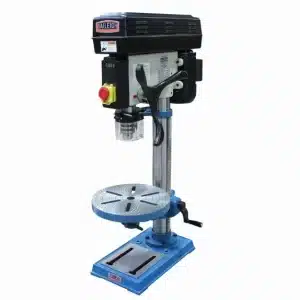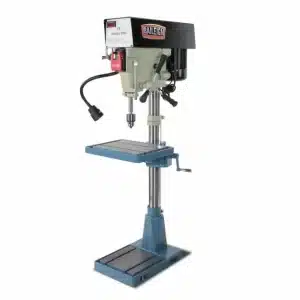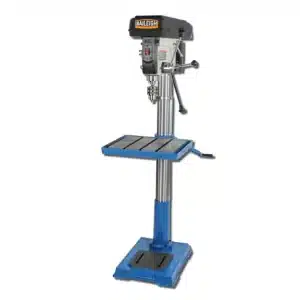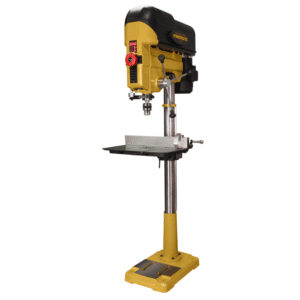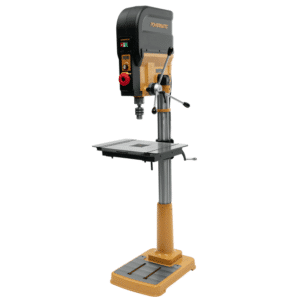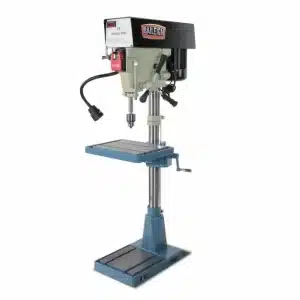Introduction to Industrial Drill Presses
A Drill Press works by rapidly rotating a tool bit and lowering it into the desired area at a predefined tool speed and feed rate to create cylindrical holes in a workpiece. The workpiece must be securely held in place on the drill table during drilling operations using vises and clamps. Most Drill Presses are oriented with the drill in the vertical position, however, some specialized drills are designed to drill horizontally. This orientation typically allows for the drilling of deep holes in long parts where a vertical arrangement would be impractical. If drilling in a different orientation is required the part will have to be repositioned. The machine speed is adjustable for different cutting tools or materials being used.
A Drill Press has several key components that work in tandem to drill precise, consistent holes. The main parts of a drilling machine are listed below:
- Base
- Column
- Arm
- Drill Head
- Worktable
- Feed Mechanism
- Spindle
- Chuck
- Electric Motor
Functionality and Applications
A Drill Press is a tool used for drilling holes in various materials, such as metal, ceramic, wood, or plastic. It can be either portable or stationary. A Drill Press is very versatile and can be used to make a variety of hole types and geometries such as drilling, reaming, countersinking, tapping, boring, and counterboring.
The base of the drilling machine supports the machine and can either be fixed to a workshop floor or mounted to a work table in the case of smaller machines. Some bases have slots to allow for bolting and holding larger workpieces that cannot fit on the table. On larger drilling machines the arm is attached to the column and is used to support the spindle and drill chuck. The arm also allows for some travel in a direction perpendicular to the column.
Smaller machines do not have an arm, and instead, have the spindle positioned relatively close to the column on the head assembly. The table provides a stable surface and can be raised or lowered to adjust the drill bit’s distance from the workpiece. The table also has T-slots or holes to facilitate the clamping of the workpiece. A sensitive drill has a much smaller worktable when compared to a gang drill, for example. A sensitive drilling machine worktable is not designed for heavy loads, whereas a gang drill’s worktable is. The feed mechanism is designed to control the rate at which the drill is lowered into the material. The optimal feed rate and the speed of the drill bit are determined by the type of material being drilled and the size of the drill bit.
The electric motor drives the spindle either directly with a gearbox or with a series of belts and pulleys. The electric motor can either be mounted to the base of the machine or at the top of the column. Like the feed rate, the rotational speed can be adjusted for different drill bits and materials. Drills that allow for tapping also need to have very low minimum speeds on the electric motor. In this case, a VSD (Variable Speed Drive) is installed.
Key Factors To Consider
Drill Presses were originally designed for metalworking trades but thanks to the availability of cutting tools, jigs, and attachments, it has become one of the most versatile tools in the workshop. It can not only drill into metal but also bore into wood and perform various woodworking operations, including mortising and sanding. In fact, next to the table saw, the Drill Press is arguably the second most important piece of equipment in the average home workshop.
Before diving into the specifics, it’s essential to understand the types of Drill Presses available:
- Benchtop Drill Presses: These compact and versatile machines are perfect for smaller workshops or occasional use.
- Floor-Standing Drill Presses: Sturdy and powerful, they are suitable for heavy-duty tasks and large projects.
- Magnetic Drill Presses: Designed for metalwork, these offer a strong magnetic base for stability on vertical surfaces.
Your choice between these types depends largely on your workspace and the materials you intend to work with.
Safety and Maintenance Tips
- Be familiar with the location of the start and stop switches.
- The Drill Press table should be cleared of miscellaneous tools and materials.
- Ensure that all drill bits are sharpened and chucks are in working condition. Any dull drill bits, battered tangs, or sockets should not be used.
- Never attempt to remove scraps from the table by hand. Use brushes or other proper tools.
- Never attempt to perform maintenance on the machine without the power cord unplugged.
- Never insert a chuck key into the chuck until the machine has been turned off and stopped completely.
- Belts and pulleys should be guarded at all times. If any are frayed, immediately report to the instructor for replacement.
- All workpieces should be secured by a vise or clamp before starting the machining.
- If the workpiece moves while in the vise or clamp:
- Do not attempt to hold the workpiece in place by hand.
- Do not try to tighten the vise or clamp while the machine is turned on.
- Turn the power off and wait for the machine to stop completely before retightening the vise or clamp.
- Use the proper speed settings and drill type for the material to be machined.
- When mounting a drill bit, it should be to the full depth and centered in the chuck.
- Eliminate the possibility of the drill bit hitting the table by using a clearance block and adjusting the feed stroke.
- Always feed the bit slowly into the workpiece. If the hole to be drilled is deep, draw the bit back often to remove shavings.
- Before leaving the Drill Press for any amount of time, the power should be turned off and the machine should be at a complete stop.
- If any unsafe condition or movement is observed on the Drill Press, report it to the manager immediately.
- Leave the Drill Press clean and tidy at all times.

